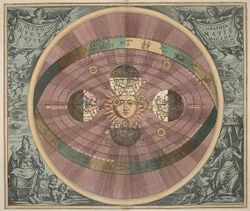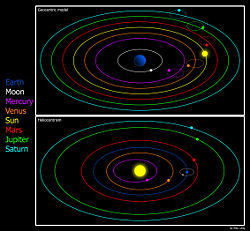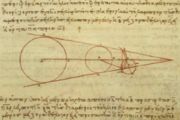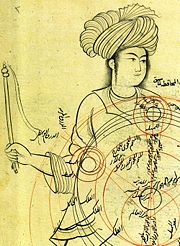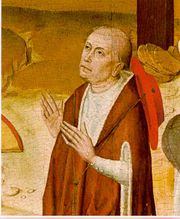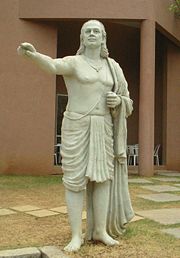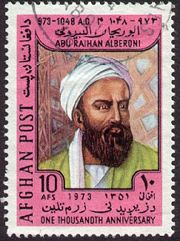Heliocentrism
2008/9 Schools Wikipedia Selection. Related subjects: Religious disputes; Space (Astronomy)
In astronomy, heliocentrism is the theory that the sun is at the centre of the Solar System. The word came from the Greek (ήλιος Helios = sun and κέντρον kentron = centre). Historically, heliocentrism is opposed to geocentrism and currently to modern geocentrism, which places the earth at the centre. (The distinction between the Solar System and the Universe was not clear until modern times, but extremely important relative to the controversy over cosmology and religion.) Although many early cosmologists such as Aristarchus speculated about the motion of the Earth around a stationary Sun, it was not until the 16th century that Copernicus presented a fully predictive mathematical model of a heliocentric system, which was later elaborated by Kepler and defended by Galileo, becoming the centre of a major dispute.
Development of heliocentrism
To anyone who stands and looks at the sky, it seems clear that the earth stays in one place while everything in the sky rises and sets or goes around once every day. Observing over a longer time, one sees more complicated movements. The Sun makes a slower circle over the course of a year; the planets have similar motions, but they sometimes turn around and move in the reverse direction for a while ( retrograde motion). As these motions became better understood, they required more and more elaborate descriptions, the most famous of which was the Ptolemaic system, formulated in the 2nd century, which, though considered incorrect today, still manages to calculate the correct positions for the planets to a moderate degree of accuracy, though Ptolemy's demand that all epicycles be not eccentric causes needless problems for the motions of Mars and especially Mercury. It is interesting to note that Ptolemy, himself, in his Almagest points out that any model for describing the motions of the planets is merely a mathematical device, and, since there is no actual way to know which is true, the simplest model that gets the right numbers should be used; however, he himself chose the epicyclic geocentric model and in his ultimate work Planetary Hypotheses treated his models as sufficiently real that the distances of moon, sun, planets and stars were determinable by treating orbits' celestial spheres as contiguous realities. This made the stars' distance less than 20 Astronomical Units — a subtraction from science since Aristarchus's heliocentric scheme had already centuries earlier necessarily placed the stars at least two orders of magnitude more distant.
Philosophical discussions
Philosophical arguments on heliocentrism involve general statements that the Sun is at the centre of the universe or that some or all of the planets revolve around the Sun, and arguments supporting these claims. These ideas can be found in a range of Sanskrit, Greek, Arabic and Latin texts. Few of these early sources, however, develop techniques to compute any observational consequences of their proposed heliocentric ideas.
Ancient India
According to theosophists, the earliest traces of a counter-intuitive idea that it is the Earth that is actually moving and the Sun that is at the centre of the solar system (hence the concept of heliocentrism) is found in several Vedic Sanskrit texts written in ancient India. Yajnavalkya (c. 9th–8th century BC) believed that the Sun was "the centre of the lokas" as described in the Vedas at the time. In his astronomical text Shatapatha Brahmana, he states:
"The sun is stationed for all time, in the middle of the day. [...] Of the sun, which is always in one and the same place, there is neither setting nor rising."
Some interpret this to mean that the Sun is stationary, hence the Earth is moving around it, though others are less clear about the meanings of the terms. This would be elaborated in a later commentary Vishnu Purana (2.8) (c. 1st century BC).
Yajnavalkya recognized that the Sun was much larger than the Earth, which would have influenced this early heliocentric concept. He also is said to have accurately measured the relative distances of the Sun and the Moon from the Earth as 108 times the respective diameters of these heavenly bodies, close to the modern measurements of 107.6 for the Sun and 110.6 for the Moon. He described an accurate solar calendar in the Shatapatha Brahmana. The Aitareya Brahmana (2.7) (c. 9th–8th century BC) also states:
"The Sun never sets nor rises. When people think the sun is setting, it is not so; they are mistaken. It only changes about after reaching the end of the day and makes night below and day to what is on the other side."
Greco-Roman world
In the 4th century BC, Aristotle wrote that:
"At the centre, they [the Pythagoreans] say, is fire, and the earth is one of the stars, creating night and day by its circular motion about the centre."
—Aristotle, On the Heavens, Book Two, Chapter 13
The reasons for this placement were philosophic based on the classical elements rather than scientific; fire was more precious than earth in the opinion of the Pythagoreans, and for this reason the fire should be central. However, the central fire is not the Sun. The Pythagoreans believed the Sun orbited the central fire along with everything else. Aristotle dismissed this argument and advocated geocentrism. Heraclides of Pontus (4th century BC) explained the apparent daily motion of the celestial sphere through the rotation of the Earth.
The first person to present an argument for a heliocentric system, however, was Aristarchus of Samos (c. 270 BC). Like Eratosthenes, Aristarchus calculated the size of the earth, and measured the size and distance of the Moon and Sun, in a treatise which has survived. From his estimates, he concluded that the Sun was six to seven times wider than the Earth and thus hundreds of times more voluminous. His writings on the heliocentric system are lost, but some information is known from surviving descriptions and critical commentary by his contemporaries, such as Archimedes. Some have suggested that his calculation of the relative size of the Earth and Sun led Aristarchus to conclude that it made more sense for the Earth to be moving than for the huge Sun to be moving around it. Though the original text has been lost, a reference in Archimedes' book The Sand Reckoner describes another work by Aristarchus in which he advanced an alternative hypothesis of the heliocentric model. Archimedes wrote:
You King Gelon are aware the 'universe' is the name given by most astronomers to the sphere the center of which is the center of the Earth, while its radius is equal to the straight line between the center of the Sun and the centre of the Earth. This is the common account as you have heard from astronomers. But Aristarchus has brought out a book consisting of certain hypotheses, wherein it appears, as a consequence of the assumptions made, that the universe is many times greater than the 'universe' just mentioned. His hypotheses are that the fixed stars and the Sun remain unmoved, that the Earth revolves about the Sun on the circumference of a circle, the Sun lying in the middle of the orbit, and that the sphere of fixed stars, situated about the same center as the Sun, is so great that the circle in which he supposes the Earth to revolve bears such a proportion to the distance of the fixed stars as the centre of the sphere bears to its surface.
Aristarchus thus believed the stars to be very far away, and saw this as the reason why there was no visible parallax, that is, an observed movement of the stars relative to each other as the Earth moved around the Sun. The stars are in fact much farther away than the distance that was generally assumed in ancient times, which is why stellar parallax is only detectable with telescopes.
Archimedes says that Aristarchus made the stars' distance larger, suggesting that he was answering the natural objection that heliocentrism requires stellar parallactic oscillations. He apparently agreed to the point but placed the stars so distant as to make the parallactic motion invisibly minuscule. Thus heliocentrism opened the way for realization that the universe was larger than the geocentrists taught.
It should be noted that Plutarch mentions the 'followers of Aristarchus' in passing, so it is likely that there are other astronomers in the Classical period who also espoused heliocentrism whose work is now lost to us. However, the only other astronomer from antiquity who is known by name and who is known to have supported Aristarchus' heliocentric model was Seleucus of Seleucia, a Mesopotamian astronomer who lived a century after Aristarchus.
In Roman Carthage, Martianus Capella (5th century A.D.) expressed the opinion that the planets Venus and Mercury did not go about the Earth but instead circled the Sun. Copernicus mentioned him as an influence on his own work.
Middle East
The Babylonian astronomer Seleucus of Seleucia (b. 190 BC) adopted the heliocentric system of Aristarchus, and according to Plutarch, may have even proved it. His proposed proof may have been related to his observations of the phenomenon of tides. Indeed Seleucus correctly theorized that tides were caused by the Moon, although he believed that the interaction was mediated by the Earth's atmosphere. He noted that the tides varied in time and strength in different parts of the world.
In the medieval Islamic civilization, due to the scientific dominance of the Ptolemaic system in early Islamic astronomy, most Muslim astronomers accepted the geocentric model. However, several Muslim scholars had discussions on whether the Earth moved and tried to explain how this might be possible.
Alhacen (Ibn al-Haytham) wrote a scathing critique of Ptolemy's model in his Doubts on Ptolemy (c. 1028), which some interpret to imply he was criticizing Ptolemy's geocentrism, but many agree that he was actually criticizing the details of Ptolemy's model rather than his geocentrism. Alhacen did, however, later propose the Earth's rotation on its axis in The Model of the Motions (c. 1038). In 1030, al-Biruni discussed the Indian astronomical theories of Aryabhata, Brahmagupta and Varahamihira in his Indica. Al-Biruni agreed with the Earth's rotation about its own axis, and while he was initially neutral regarding the heliocentric and geocentric models, he noted that heliocentrism was a philosophical problem, rather than a mathematical problem. Abu Said al-Sijzi, a contemporary of al-Biruni, suggested the possible movement of the Earth around the Sun, which Biruni did not reject. Qutb al-Din (b. 1236), in his The Limit of Accomplishment concerning Knowledge of the Heavens, also discussed whether heliocentrism was a possibility.
Medieval Europe
Heliocentric ideas were known in Europe before Copernicus. Explorers and traders were increasingly venturing out beyond Europe and introducing the West to the Indian heliocentric traditions as detailed above (cf. the Silk Road and Muslim commentators). Scholars were also aware of the arguments of Aristarchus and Philolaus, as well as several other thinkers who had proposed (or were alleged to have proposed) heliocentric or quasi-heliocentric views, such as Hicetas, Heraclides Ponticus, and Martianus Capella.
During the Late Middle Ages, Bishop Nicole Oresme discussed the possibility that the Earth rotated on its axis, while Cardinal Nicholas of Cusa in his Learned Ignorance asked whether there was any reason to assert that the Sun (or any other point) was the centre of the universe. In parallel to a mystical definition of God, Cusa wrote that "Thus the fabric of the world (machina mundi) will quasi have its centre everywhere and circumference nowhere."
Mathematical astronomy
In mathematical astronomy, computational models of heliocentrism involve mathematical computational systems that are tied to a heliocentric model and where positions of the planets can be computed. The first computational system explicitly tied to a heliocentric model was the Copernican model described by Copernicus, but there were earlier computational systems that may have implied some form of heliocentricity, notably Aryabhata's model, which has astronomical parameters which some have interpreted to imply a form of heliocentricity. Several Muslim astronomers also developed computational systems with astronomical parameters compatible with heliocentricity, as stated by Biruni, but the concept of heliocentrism was considered a philosophical problem rather than a mathematical problem. Their astronomical parameters, however, were later adapted in the Copernican model in a heliocentric context.
Medieval India
Aryabhata (476–550), in his magnum opus Aryabhatiya, propounded a computational system based on a planetary model in which the Earth was taken to be spinning on its axis and the periods of the planets were given with respect to the Sun. Some have interpreted this to be a heliocentric model, but this view has been disputed by others. He was also the first to discover that the light from the Moon and the planets was reflected from the Sun, and that the planets follow elliptical orbits, on which he accurately calculated many astronomical constants, such as the periods of the planets, times of the solar and lunar eclipses, and the instantaneous motion of the Moon (expressed as a differential equation). Early followers of Aryabhata's model included Varahamihira, Brahmagupta, and Bhaskara II. Arabic translations of Aryabhata's Aryabhatiya were available from the 8th century, while Latin translations were available from the 13th century, before Copernicus had written De revolutionibus orbium coelestium, so it is possible that Aryabhata's work had an influence on Copernicus' ideas.
Nilakantha Somayaji (1444-1544), in his Aryabhatiyabhasya, a commentary on Aryabhata's Aryabhatiya, developed a computational system for a partially heliocentric planetary model, in which the planets orbit the Sun, which in turn orbits the Earth, similar to the Tychonic system later proposed by Tycho Brahe in the late 16th century. Nilakantha's system, however, was mathematically more effient than the Tychonic system, due to correctly taking into account the equation of the centre and latitudinal motion of Mercury and Venus. Most astronomers of the Kerala school of astronomy and mathematics who followed him accepted his planetary model.
Middle East
In the 2nd century BC, the Babylonian astronomer Seleucus of Seleucia is said to have proved the heliocentric theory. According to Bartel Leendert van der Waerden, Seleucus may have proved the heliocentric theory by determining the constants of a geometric model for the heliocentric theory and by developing methods to compute planetary positions using this model. He may have used trigonometric methods that were available in his time, as he was a contemporary of Hipparchus.
In the 9th century, the Afghan astronomer Ja'far ibn Muhammad Abu Ma'shar al-Balkhi developed a planetary model which can be interpreted as a heliocentric model. This is due to his orbital revolutions of the planets being given as heliocentric revolutions rather than geocentric revolutions, and the only known planetary theory in which this occurs is in the heliocentric theory. His work on planetary theory has not survived, but his astronomical data was later recorded by al-Hashimi and Abū Rayhān al-Bīrūnī.
Al-Biruni discussed the possibility of whether the Earth rotated about its own axis and around the Sun, but in his Masudic Canon, he set forth the principles that the Earth is at the centre of the universe and that it has no motion of its own. He was aware that if the Earth rotated on its axis and around the Sun, this would be consistent with his astronomical parameters, but he considered this a philosophical problem rather than a mathematical problem.
Nasir al-Din al-Tusi (b. 1201) resolved significant problems in the Ptolemaic system by developing the Tusi-couple as an alternative to the physically problematic equant introduced by Ptolemy. 'Umar al-Katibi al- Qazwini (d. 1277), who also worked at the Maragheh observatory, in his Hikmat al-'Ain, wrote an argument for a heliocentric model, but later abandoned the model. Ibn al-Shatir (b. 1304) eliminated the need for an equant, proposing a system that was only approximately geocentric, rather than exactly so, having demonstrated trigonometrically that the Earth was not the exact centre of the universe. His rectification was later used in the Copernican model, along with the earlier Tusi-couple and the Urdi lemma of Mo'ayyeduddin Urdi. Their theorems played an important role in the Copernican model of heliocentrism, which was achieved by reversing the direction of the last vector connecting the Earth to the Sun. In the published version of his masterwork, Copernicus also cites the theories of Albategni, Arzachel and Averroes as influences, while the works of Alhacen and Biruni were also known in Europe at the time.
Renaissance Europe
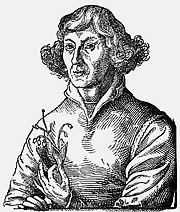
In the 16th century, Nicolaus Copernicus's De revolutionibus presented a full discussion of a heliocentric model of the universe in much the same way as Ptolemy's Almagest had presented his geocentric model in the 2nd century. Copernicus discussed the philosophical implications of his proposed system, elaborated it in full geometrical detail, used selected astronomical observations to derive the parameters of his model from a series of astronomical observations, and wrote astronomical tables which enabled one to compute the past and future positions of the stars and planets. In doing so, Copernicus moved heliocentrism from philosophical speculation to predictive geometrical astronomy. This theory resolved the issue of planetary retrograde motion by arguing that such motion was only perceived and apparent, rather than real: it was a parallax effect, as a car that one is passing seems to move backwards against the horizon. This issue was also resolved in the geocentric Tychonic system; the latter, however, while eliminating the major epicycles, retained as a physical reality the irregular back-and-forth motion of the planets, which Kepler characterized as a " pretzel."
Copernicus cited Aristarchus in an early (unpublished) manuscript of De Revolutionibus (which still survives) so he was clearly aware of at least one previous proponent of the heliocentric thesis. However, in the published version he restricts himself to noting that in works by Cicero he had found an account of the theories of Hicetas and that Plutarch had provided him with an account of the Pythagoreans Heraclides Ponticus, Philolaus, and Ecphantus. These authors had proposed a moving earth, which did not, however, revolve around a central sun.
Religious attitudes to heliocentrism
Psalm 93:1, Psalm 96:10, and I Chronicles 16:30 state that "the world is firmly established, it cannot be moved." Psalm 104:5 says, "[the Lord] set the earth on its foundations; it can never be moved." Ecclesiastes 1:5 states that "the sun rises and the sun sets, and hurries back to where it rises."
Galileo defended heliocentrism, and claimed it was not contrary to those Scripture passages. He took Augustine's position on Scripture: not to take every passage literally, particularly when the scripture in question is a book of poetry and songs, not a book of instructions or history. The writers of the Scripture wrote from the perspective of the terrestrial world, and from that vantage point the sun does rise and set. In fact, it is the earth's rotation which gives the impression of the sun in motion across the sky.
One of the few pieces of information we have about the reception of Aristarchus's heliocentric system comes from a passage in Plutarch's dialogue, Concerning the Face which Appears in the Orb of the Moon. According to one of Plutarch's characters in the dialogue, the philosopher Cleanthes had held that Aristarchus should be charged with impiety for "moving the hearth of the world". In fact, however, Aristarchus's heliocentrism appears to have attracted little attention, religious or otherwise, until Copernicus revived and elaborated it.
Nicolaus Copernicus published the definitive statement of his system in De Revolutionibus in 1543. Copernicus began to write it in 1506 and finished it in 1530, but did not publish it until the year of his death. Although he was in good standing with the Church and had dedicated the book to Pope Paul III, the published form contained an unsigned preface by Osiander stating that the system was a pure mathematical device and was not supposed to represent reality. Possibly because of that preface, the work of Copernicus inspired very little debate on whether it might be heretical during the next 60 years.
There was an early suggestion among Dominicans that the teaching should be banned, but nothing came of it at the time. Some Protestants, however, voiced strong opinions during the 16th century. Martin Luther once said:
"There is talk of a new astrologer who wants to prove that the earth moves and goes around instead of the sky, the sun, the moon, just as if somebody were moving in a carriage or ship might hold that he was sitting still and at rest while the earth and the trees walked and moved. But that is how things are nowadays: when a man wishes to be clever he must . . . invent something special, and the way he does it must needs be the best! The fool wants to turn the whole art of astronomy upside-down. However, as Holy Scripture tells us, so did Joshua bid the sun to stand still and not the earth."
This was reported in the context of dinner-table conversation and not a formal statement of faith. Melanchthon, however, opposed the doctrine over a period of years.
Some years after the publication of De Revolutionibus John Calvin preached a sermon in which he denounced those who "pervert the course of nature" by saying that "the sun does not move and that it is the earth that revolves and that it turns". On the other hand, Calvin is not responsible for another famous quotation which has often been misattributed to him:
"Who will venture to place the authority of Copernicus above that of the Holy Spirit?"
It has long been established that this line cannot be found in any of Calvin's works. It has been suggested that the quotation was originally sourced from the works of Lutheran theologian Abraham Calovius.
Over time, however, the Catholic Church began to become more adamant about protecting the geocentric view. Pope Urban VIII, who had approved the idea of Galileo's publishing a work on the two theories of the world, became hostile to Galileo. Over time, the Catholic Church became the primary opposition to the Heliocentric view.
The favored system had been that of Ptolemy, in which the Earth was the centre of the universe and all celestial bodies orbited it. A geocentric compromise was available in the Tychonic system, in which the Sun orbited the Earth, while the planets orbited the Sun as in the Copernican model. The Jesuit astronomers in Rome were at first unreceptive to Tycho's system; the most prominent, Clavius, commented that Tycho was "confusing all of astronomy, because he wants to have Mars lower than the Sun." (Fantoli, 2003, p. 109) But as the controversy progressed and the Church took a harder line toward Copernican ideas after 1616, the Jesuits moved toward Tycho's teachings; after 1633, the use of this system was almost mandatory. For advancing heliocentric theory Galileo was put under house arrest for the last several years of his life.
Theologian and pastor Thomas Schirrmacher, however, has argued:
"Contrary to legend, Galileo and the Copernican system were well regarded by church officials. Galileo was the victim of his own arrogance, the envy of his colleagues, and the politics of Pope Urban VIII. He was not accused of criticizing the Bible, but disobeying a papal decree."
Catholic scientists also:
"appreciated that the reference to heresy in connection with Galileo or Copernicus had no general or theological significance."
—Heilbron (1999)
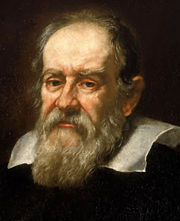
Cardinal Robert Bellarmine himself considered that Galileo's model made "excellent good sense" on the ground of mathematical simplicity; that is, as a hypothesis (see above). And he said:
"If there were a real proof that the Sun is in the centre of the universe, that the Earth is in the third sphere, and that the Sun does not go round the Earth but the Earth round the Sun, then we should have to proceed with great circumspection in explaining passages of Scripture which appear to teach the contrary, and we should rather have to say that we did not understand them than declare an opinion false which has been proved to be true. But I do not think there is any such proof since none has been shown to me."
—Koestler (1959), p. 447–448
Therefore, he supported a ban on the teaching of the idea as anything but hypothesis. In 1616 he delivered to Galileo the papal command not to "hold or defend" the heliocentric idea. In the discussions leading to the ban, he was a moderate, as the Dominican party wished to forbid teaching heliocentrism in any way whatever. Galileo's heresy trial in 1633 involved making fine distinctions between "teaching" and "holding and defending as true".
The official opposition of the Church to heliocentrism did not by any means imply opposition to all astronomy; indeed, it needed observational data to maintain its calendar. In support of this effort it allowed the cathedrals themselves to be used as solar observatories called meridiane; i.e., they were turned into "reverse sundials", or gigantic pinhole cameras, where the Sun's image was projected from a hole in a window in the cathedral's lantern onto a meridian line.
In 1664, Pope Alexander VII published his Index Librorum Prohibitorum Alexandri VII Pontificis Maximi jussu editus which included all previous condemnations of geocentric books. An annotated copy of Philosophiae Naturalis Principia Mathematica by Isaac Newton was published in 1742 by Fathers le Seur and Jacquier of the Franciscan Minims, two Catholic mathematicians with a preface stating that the author's work assumed heliocentrism and could not be explained without the theory. Pope Benedict XIV suspended the ban on heliocentric works on April 16, 1757 based on Isaac Newton's work. Pope Pius VII approved a decree in 1822 by the Sacred Congregation of the Inquisition to allow the printing of heliocentric books in Rome.
The view of modern science
The realization that the heliocentric view was also not true in a strict sense was achieved in steps. That the Sun was not the centre of the universe, but one of innumerable stars, was strongly advocated by the mystic Giordano Bruno; Galileo made the same point, but said very little on the matter, perhaps not wishing to incur the church's wrath. Over the course of the 18th and 19th centuries, the status of the Sun as merely one star among many became increasingly obvious. By the 20th century, even before the discovery that there are many galaxies, it was no longer an issue.
Even if the discussion is limited to the solar system, the sun is not at the geometric centre of any planet's orbit, but rather at one focus of the elliptical orbit. Furthermore, to the extent that a planet's mass cannot be neglected in comparison to the Sun's mass, the center of gravity of the solar system is displaced slightly away from the centre of the Sun. (The masses of the planets, mostly Jupiter, amount to 0.14% of that of the Sun.) Therefore a hypothetical astronomer on an extrasolar planet would observe a "wobble" in his perception of the Sun's motion.
Giving up the whole concept of being "at rest" is related to the principle of relativity. While, assuming an unbounded universe, it was clear there is no privileged position in space, until postulation of the special theory of relativity by Albert Einstein, at least the existence of a privileged class of inertial systems absolutely at rest was assumed, in particular in the form of the hypothesis of the luminiferous aether. Some forms of Mach's principle consider the frame at rest with respect to the masses in the universe to have special properties.
Modern use of geocentric and heliocentric
In modern calculations, the origin and orientation of a coordinate system often have to be selected. For practical reasons, systems with their origin in the mass, solar mass or in the centre of mass of solar system are frequently selected. The adjectives may be used in this context. However, such selection of coordinates has no philosophical or physical implications.
